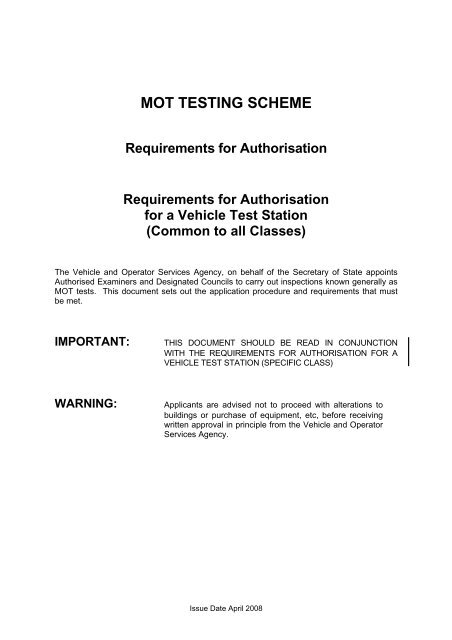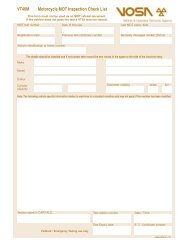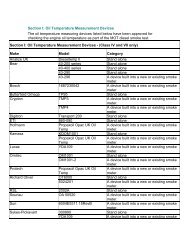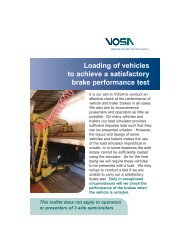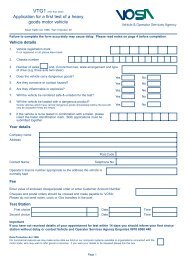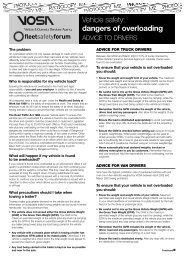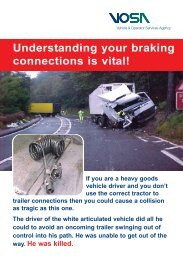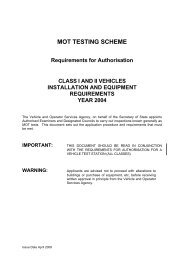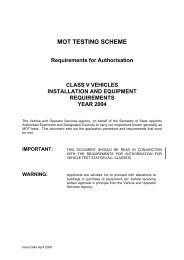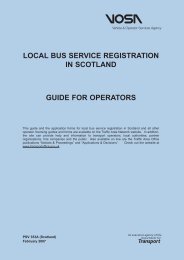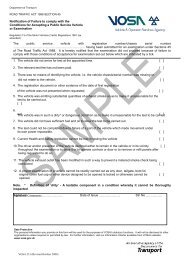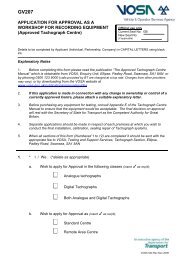MOT TESTING SCHEME Requirements for Authorisation ...
MOT TESTING SCHEME Requirements for Authorisation ...
MOT TESTING SCHEME Requirements for Authorisation ...
You also want an ePaper? Increase the reach of your titles
YUMPU automatically turns print PDFs into web optimized ePapers that Google loves.
<strong>Requirements</strong> <strong>for</strong> <strong>Authorisation</strong> <strong>for</strong> a Vehicle TestStation (All Classes)1.0 Introduction1 This section details the requirements <strong>for</strong> those applying to have a site approved asa VTS or seeking approval <strong>for</strong> changes to an existing VTS. It covers:• How to Apply• Application Enclosures• <strong>Requirements</strong> <strong>for</strong> Premises• Equipment <strong>Requirements</strong>• <strong>MOT</strong> Testing Signs and Notices• Acceptable Variations to Layout and Equipment2.0 How to Apply1 Applications must be made on the current Application <strong>for</strong> <strong>MOT</strong> <strong>Authorisation</strong> Form(VT01). All relevant sections should be completed and the signed <strong>for</strong>m returned toa local VOSA Office along with any requested enclosures as outlined in this section.2 Those applying should not submit their application until confident that it will fullymeet all the requirements, approval to test will only be granted to applicants whoalso meet the requirements to be an Authorised Examiner or are alreadyauthorised.3 The requirements in this section should be read in conjunction with the ClassSpecific <strong>Requirements</strong> (<strong>for</strong> classes approval is sort) and the List of AcceptableEquipment.Note: If the applicant proposes to carry out building alterations or obtain newequipment, it is recommended that this is not done be<strong>for</strong>e VOSA has givenapproval in principle to the application.3.0 Application Enclosures1 Applications <strong>for</strong> a new site to be approved <strong>for</strong> testing or alterations to existing siteswill need to be supported by the following evidence;a) site plan showing the buildings, the location of the testing bay, theaccess from and to the public highway, the proposed parking area <strong>for</strong> <strong>MOT</strong>test vehicles and the location of the <strong>MOT</strong> notice board;b) a fully dimensioned drawing of the proposed testing bay, or bays,showing adjacent equipment and parts of the building, the location of the testequipment, the position and dimensions of the entrances and exits, and thearea from which the test may be observedc) planning permission (or an exemption), or written confirmation fromthe Local Authority that the existing approval covers <strong>MOT</strong> testing;Issue Date April 2008 1 / 7
Note: The plan and drawings must show that the site will met the requirementsoutlined in this section and the requirements <strong>for</strong> the class(es) approval to test issort.4.0 <strong>Requirements</strong> <strong>for</strong> premisesFor a site to be considered <strong>for</strong> approval it must provide the following.4.1 Premises with:a) a test bay and observation area housed in a weatherproof building.The building although weatherproof need not be draught-free, but mustbe capable of being totally enclosed and provide a satisfactory workingarea. The test facilities must be reasonably free from oil contamination,exhaust fumes, noise or other pollution from adjacent work areas;b) equipment laid out so that testing can be per<strong>for</strong>med effectively. Theequipment should be laid out and located so that other garage activitieswill not effect the proper conduct of the test;c) an unobstructed safe and easy access via a metalled road from thesite entrance to the building entrance, such that vehicles can enter andleave the site in a <strong>for</strong>ward direction. If the site entrance is not on a publicroad, the metalled requirement cannot be insisted upon <strong>for</strong> roads outsidethe site on which the premises are situated. If the site entrance is on apublic road it must be possible to drive into and out of the premises in a<strong>for</strong>ward direction. A metalled road does not need to be bonded. Clearly itneeds to be a reasonable surface which is not likely to damage vehicles;d) adequate off road parking;e) a clearly identified, warm and weatherproof public waiting room orarea from which the whole test can be directly observed withoutinterruption, except <strong>for</strong> road testing (room <strong>for</strong> 2 seated people isconsidered sufficient). Directly observed means that <strong>for</strong> example mirrorsor close circuit TV are not acceptable. The observation room or areashould be identified by a notice and floor markings if applicable. Thereshould also be a notice in reception indicating the presence of a viewingarea;f) a suitable location or route <strong>for</strong> the conducting decelerometer braketests.4.2 A test bay with:a) clear unobstructed access from the entrance of the building;b) vehicle entrances and exits that con<strong>for</strong>m to the dimensions applicableto the class(es) <strong>for</strong> which authorisation is sought;Issue Date April 2008 2/7
c) a width which con<strong>for</strong>ms to the dimensions applicable to the classeswhich authorisation is sought. Minor intrusions such as wall piers mayencroach on these dimensions provided vehicle testing is not impeded.'Minor intrusion' means any part of the building structure or other fixtureswhich come within the minimum bay outline. They must be so positionedthat vehicle movement and the recommended method of inspection arenot impeded. Items of equipment other than the brake tester consoleand a desk surface <strong>for</strong> <strong>MOT</strong> purposes are not normally permitted;d) headroom which con<strong>for</strong>ms to the dimensions applicable to theclass(es) <strong>for</strong> which authorisation is sought;e) adequate general illumination. There must be sufficient artificiallighting to enable testing to be carried out without difficulty.4.3 A layout:a) Which con<strong>for</strong>ms to the requirements of the class <strong>for</strong> whichauthorisation is sought;b) without walls or partitions between adjacent test bays;c) with at least the dimensions between the centre lines of testequipment in adjacent bays which is applicable to the classes <strong>for</strong> whichauthorisation is sought. Test equipment to be centrally located in testbays (not applicable Classes I & II);d) with at least 0.5m clearance around all parts of a lift, includingcontrol boxes. (not applicable to Classes I & II).<strong>MOT</strong> Testing Distraction or Disruption.There is an increased likelihood of distraction and disruption to <strong>MOT</strong> tests whenbays are not separated by walls, etc. from other activities on the premises.New applicants should be aware that where VOSA considers there may be a risk oftesting distraction or disruption, they may be asked to clearly outline the boundariesof the test bays in 'open plan' workshops/premises. Test bays must then be keptclear of all non-<strong>MOT</strong> testing activities and equipment. Where it is obvious that otheractivities or 'people traffic' (e.g. stores counters, rest rooms, spares racks, etc.)could encroach onto a test bay, 1m high barriers preventing this and, if appropriate,suitable notices will be required.Existing testing stations that make alterations increasing the likelihood of testingdistraction or disruption may be required to comply with the above paragraph.Issue Date April 2008 3/7
5.0 Equipment <strong>Requirements</strong>5.1 Major Equipment1. A means of allowing the underside of vehicles to be properlyexamined without obstruction or hindrance; (fitted with steering andsuspension play detectors off the VOSA list of acceptable equipment if anATL or OPTL installation);A Testing Station may be permitted to have more than one undersideinspection facility which share the same brake tester, headlamp testing areaand emissions equipment providing;i) the underside facilities are in the same building and the baysare adjacent or close to each other;ii) the additional underside facility meets the requirements <strong>for</strong> theclass(es) tested;iii) if the additional underside facility is used as a headlampstanding area then it must have a dedicated headlamp aim tester.The facility must also meet all the requirements associated withheadlamp testing, including level and calibration certificates;iv) the viewing area has an unrestricted view of all the testingfacilities, if this cannot be achieved from one viewing area thenadditional viewing areas must be provided;v) the provision of the additional underside inspection facility doesnot adversely affect the standard of the test.The final decision on granting authorisation to an applicant who wishes toinstall more than one underside inspection facility rests with the VOSA localarea manager. It will be judged on the effect that the installation has on theprimary facility.2. A headlamp aim testing facility, this equipment must be approved tothe 2005 Headlamp Beam Tester specification if installed in an ATL;3. Brake testing equipment (fully automated if an ATL installation);4. Emissions testing equipment; (if applicable)All testing equipment must be kept in good working order. Measuring apparatusmust be calibrated in accordance with VOSA’s requirements. If an Item ofmandatory test equipment is not re-calibrated by its due date then testing whichuses that item will be prevented until the item is re-calibrated. Calibration detailsmust be accurately entered onto the VTS Device as soon as practicable aftercalibration has been satisfactorily completedAutomated Test LanesAutomated Test Lanes can be installed to any of the suggested layouts contained inthe Class III & IV Vehicles Installation and Equipment <strong>Requirements</strong>, howeverIssue Date April 2008 4/7
authorisation will only be granted <strong>for</strong> installations that meet the full conditions anddimensions as set out in the relevant sections with in the Application Pack.5.2 Miscellaneous Equipment:1. a tyre tread depth gauge selected from VOSA’s latest list ofacceptable equipment;2. corrosion assessment tool;3. suitable pinch bars, long and short (N/A classes I & II);4. a steel tape measure (min extended length 1.0m);5. suitable wheel chocks <strong>for</strong> the class(es) of vehicle to be tested (notapplicable classes I & II;6. brake pedal application device off the VOSA list of acceptableequipment (only mandatory <strong>for</strong> ATL & OPTL installations);7. suitably positioned mirrors or colour CCTV system <strong>for</strong> lighting checks(only mandatory <strong>for</strong> ATL & OPTL installations).8. a hand held low voltage inspection lamp, (Note: clip-on battery typesare not acceptable);The hand lamp should preferably be a 'lead lamp', but re-chargeable or batterylamps can be acceptable. 'Low voltage' is regarded as 24 volts or less. 110 voltsfrom a centre earth tapped trans<strong>for</strong>mer (i.e. 2x55) can be accepted (In the case ofclass V the lamp supply lead shall be captive to a system of running eyes along arail or cable such that the lead cannot trail either on the pit or workshop floor).6.0 <strong>MOT</strong> Testing Signs and Notices1. A Vehicle Testing Station sign (three triangles detailed in ‘The TrafficSigns Regulations and General Directions 2002, Schedule 4, diagram 864').The prescribed testing station sign to be displayed in a prominent position,no part higher than 4.5m from the ground and no more than one sign oneach road frontage.2. VTSs must display a "Diesels Tested" sign in appropriate positionoutside the VTS if appropriate to the vehicles that they are authorised to test(as detailed in Appendix 2 of the <strong>MOT</strong> Testing Guide). Display of the‘catalysts tested’ sign is voluntary.3. The business trading name as described within either the Companiesor the Business Names Acts is displayed conspicuous and legibly.4. An <strong>MOT</strong> notice board with a protective transparent covering sopositioned that VOSA notices can easily be read by anyone submittingIssue Date April 2008 5/7
vehicles <strong>for</strong> test. The board must be of sufficient size to accommodate atleast six A4 notices (Portrait).7.0 Acceptable Variations to Layout and Equipment7.1 Layout and EquipmentProvided there is no change in the class of vehicles tested and the securityrequirements are complied with, particular variations will be allowed <strong>for</strong> AuthorisedExaminers and applicants as shown below.a) Existing Authorised Examiners moving their test bay orequipment within their present building(s).The test bay and equipment layout of these existing Authorised Examinerswill be considered suitable if they meet the requirements as laid down insection 3.0 to 5.0 above, except where it would be impossible to do sowithout major structural alteration, such as significant work to the roof, flooror load-bearing walls.Test equipment requirements will be considered met if the existingAuthorised Examiner retains his current equipment. If new equipment isobtained, it must meet the current relevant requirements.b) New applicants or existing Authorised Examiners moving intopreviously authorised premises using an existing test bay where an NThas carried out a test and issued a test certificate within the previous12 months.The test bay and equipment layout of new applicants moving into previouslyauthorised premises will be considered suitable if they meet the<strong>Requirements</strong> <strong>for</strong> <strong>Authorisation</strong>s (previously called Conditions ofAppointment) that were current when the site was last accepted.Occasionally, certain updates will have to be complied with i.e. testequipment, tools etc. Advice should be sought from local VOSA Office atinitial inspection.Test equipment requirements will be considered met if the equipment lastused <strong>for</strong> <strong>MOT</strong> testing is retained, provided that it is still in full working order.However, any changes to required equipment that would have beennecessary had the premises been in continuous testing must also becomplied with.Note: The Salter type brake meter (pull along brake tester) is not acceptable<strong>for</strong> new or re-authorisations.Issue Date April 2008 6/7
7.2 Authorised Examiners and new applicants in remote rural areasThe premises, equipment layout and equipment of Authorised Examiners and newapplicants in remote rural areas will be considered suitable if the requirements aremet in VOSA’s view as far as is reasonably possible.To be considered <strong>for</strong> remote rural area status:a) the premises must be 15 miles or more by road from a testing stationthat meets the specification as laid down in Section 3.0 to 5.0 or as varied by7.1a.b) not more than 350 tests per year are or will be carried out.Brake and headlamp test equipment will normally be selected from VOSA’s latestList of Acceptable Equipment.6.2 Exceptionally, (excluding steering and suspension play detectors andautomated roller brake testers) where a manufacturer has sought acceptance of hisequipment but VOSA has not assessed its suitability, applicants may useequipment not on the List of Acceptable Equipment, provided the application issupported by:a) a certificate signed by the manufacturer, or recognised agent in thecase of imported equipment, that it meets the per<strong>for</strong>mance specification andis correctly installed;b) an undertaking signed by the applicant that he will cease testing untilthe equipment is replaced or modified if subsequently VOSA decides that itdoes not meet its specification or it is not correctly installed. (A reasonabletime will be allowed <strong>for</strong> the manufacturer to gain acceptance <strong>for</strong> newequipment).All applicants that wish to use any equipment not on VOSA’s list of AcceptableEquipment will be referred to VOSA Headquarters.Note: This exception is not be applicable to ATL equipment and there<strong>for</strong>e an ATLtest station will not be authorised until all appropriate approval certificates have beenissued.WARNING: Adequate passageway clearance must be provided around testingfacilities. In restricted test bays, this may not be achievable with some standardspecification test equipment (e.g. lifts with motors on a column).Issue Date April 2008 7/7


